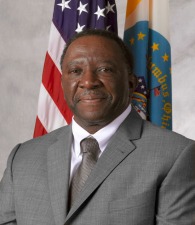- Overview
-
Degrees & Certificates
- Certificates
- Programs by Category
- Partner Solutions & Training
- Why CPSCE
- Events & Resources
- About The Center
Spotlight: Dr. Ned Pettus Jr., Director of Public Safety for the City of Columbus

October 2, 2019
We are honored to have on our Advisory Board Dr. Ned Pettus Jr., the Director of Public Safety for the City of Columbus. Director Pettus has had a long career in public service, most recently as the Fire Chief for the Columbus Division of Fire. We are excited to share with you his story of discovering firefighting as a career and his insights on the growing role of technology in public safety.
When I was a teenager, some of my friends and I played basketball with an adult neighbor, his brothers, and a friend of his who happened to be a firefighter (the late Captain William “Smitty” Smith.) All of us teenagers were thoroughly impressed that this African-American man was a firefighter, as we had never met one on such a personal level.
Several years later, while working at what was then called University Hospital, today, The Ohio State University/Wexner Medical Center, I learned how to perform CPR and conduct patient assessments, including taking blood pressures and vital signs. One day the Head Nurse (the late Mrs. Laura Dowe) told me that the Columbus Fire Department was conducting a recruitment drive at the fire station on Champion and Long, and she thought I “would make a great firefighter!” Two other nurses, Ms. Gail Talbert and Ms. Elizabeth “Liz” Parker, also encouraged me to take the test. They felt that the skills I had already learned would be useful as a firefighter. They were incredible mentors, and the rest is history!
I wasn’t really sure what I wanted to do long-term until after I joined Columbus Fire and realized I had found my niche! Back then, one of the officers at the Training Academy frequently stated that “firefighters are jacks-of-all-trades and masters of firefighting!” The ability to learn so much and learn continuously, to stay physically fit, and to work as part of a team to save lives and property seemed tailor-made for me!
Today, one of the things I find most fascinating is how public safety has evolved over the years, especially as it relates to the use of technology, and hence, the importance of cybersecurity.
First, technology has enabled first-responders to operate much more safely and efficiently, as well as to save more lives and property than previously. Examples are too numerous to list, but it is important to mention that communication is indispensable.
The 911 network is a vital part of our nation's emergency response and disaster preparedness system, and our network is constantly being upgraded to provide emergency help more quickly and effectively. Dialing 911 quickly connects you to a Public Safety Answering Point (PSAP) dispatcher trained to route your call to local emergency medical, fire and law enforcement agencies. Columbus is the 14th largest city in the U.S. and its 911 Dispatch Center provides dispatching services for a number of other local jurisdictions.
Second, drones have quickly become a vital tool for Fire and Police departments, proving its capability for search and rescue, surveillance, crash reconstruction, 3D mapping, scene over-watch, and many other scenarios.
Finally, cyberattacks have the potential to cripple public safety departments and jeopardize first responders' ability to protect lives and property, especially in metropolitan jurisdictions with mutual-aid agreements in place. Metropolitan jurisdictions manage and have access to an unimaginable volume of data, some of which are public records, while others are confidential and even protected information.
The advent of wireless communications and interagency data sharing has raised concerns about information security. Public safety relies on communications, and the security of that information is critical.
Interoperable networks are a critical component to multi-jurisdictional collaboration during major incidents. On February 12, 2012, the US government signed FirstNet into law starting the implementation of the first nationwide broadband network specifically designed for public safety. After each state connects their Radio Access Network (RAN) to the FirstNet core network, public safety jurisdictions all over the U.S. will be able to collaborate and share data across federal, state and local lines for the first time.
Cyber security involves protecting that information by preventing, detecting and responding to attacks.
Those are just a few examples of the things that fascinate me about today’s public safety environment.
Never in my wildest dreams did I imagine I would become the first African-American Fire Chief in the history of the 14th largest city in America; or become the President (now Past-President) of the Metropolitan Fire Chiefs Association; or become the Director of Public Safety for the City of Columbus, Ohio.
To say that the aforementioned “fascinates” me is putting it mildly!